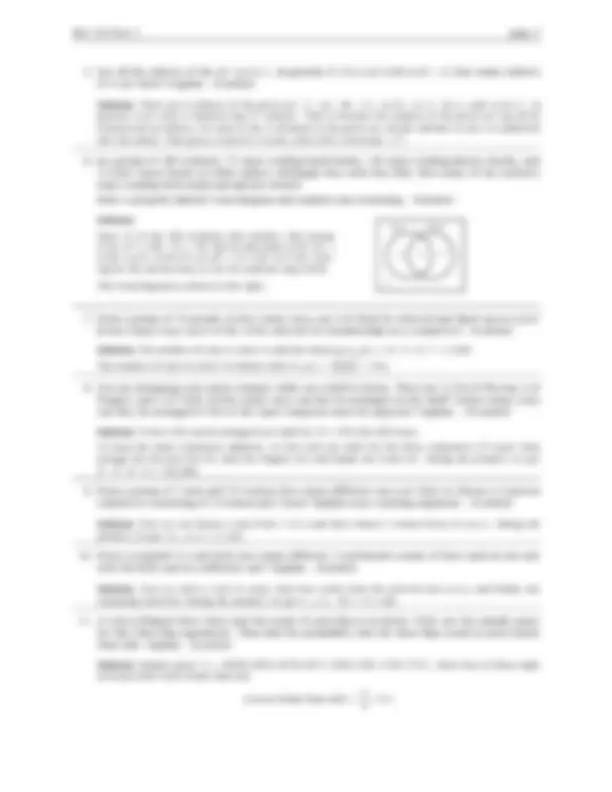



Study with the several resources on Docsity

Earn points by helping other students or get them with a premium plan


Prepare for your exams
Study with the several resources on Docsity

Earn points to download
Earn points by helping other students or get them with a premium plan
Community
Ask the community for help and clear up your study doubts
Discover the best universities in your country according to Docsity users
Free resources
Download our free guides on studying techniques, anxiety management strategies, and thesis advice from Docsity tutors
Main points of this past exam are: Converse, Venn Diagram, Mechanics, Argument, Statement, Symbolic Form, Complete
Typology: Exercises
1 / 2

This page cannot be seen from the preview
Don't miss anything!


Therefore,Sue is a man.
Solution: From the Venn diagram,we see that since Sue is a mechanic and all mechanics are men,Sue must indeed be a mechanic. The argument is Valid.
Mechanics
Men
X
Sue
Solution: The converse of the statement is q → p and the inverse is ˜ p → (^) ˜ q. p q (^) ˜ p (^) ˜ q q → p (^) ˜ p → (^) ˜ q T T F F T T T F F T T T F T T F F F F F T T T T Since the truth tables are the same,the two statements are logically equivalent.
If the defendant goes to jail,then the defendant is not innocent. If the defendant’s lawyer is good,then the defendant does not go to jail. The defendant does not go to jail. Therefore,the defendant is innocent or the lawyer is good.
Solution: Use the symbolic representations p : the defendant goes to jail; q : the defendant is innocent; r : the lawyer is good. Then the paragraph can be written as
(p → (^) ˜ q) ∧ (r → (^) ˜ p) ∧ (^) ˜ p
q ∨ r
which turns out to have one F in the truth table. So the argument is invalid. p q r (^) ˜ p (^) ˜ q p → (^) ˜ q r → (^) ˜ p (p → (^) ˜ q) ∧ (r → (^) ˜ p) ∧ (^) ˜ p q ∨ r
( (p → (^) ˜ q) ∧ (r → (^) ˜ p) ∧ (^) ˜ p
) → ( q ∨ r ) T T T F F F F F T T T T F F F F T F T T T F T F T T F F T T T F F F T T T F F T F T T T F T T T T T F T F T F T T T T T F F T T T T T T T T F F F T T T T T F F
Solution: The set A ∪ B ′^ consists of all the elements in A to- gether with those that are not in B. So, A ∪ B ′^ = { a, b, c, d, g, h, i, j, k, l, n }. The Venn diagram for (A ∪ B) ′^ is shown to the right.
A
U B
MA 110 Test 1 page 2
Solution: There are 8 subsets of the given set: {}, { a }, { b }, { c }, { a, b }, { a, c }, { b, c },and { a, b, c }. In general,a set with n elements has 2 n^ subsets. That is because the subsets of the given set can all be constructed as follows: for each of the n elements in the given set,decide whether or not it is admitted into the subset. That gives a total of n events,each with 2 outcomes – 2 n.
Solution: Since 55 of the 200 students play neither,that means n(M ∪ P ) = 200 − 55 = 145. But we also know n(M ∪ P ) = n(M) + n(P ) − n(M ∩ P ) ,so 145 = 75 + 126 − n(T ∩ R). Solv- ing for the intersection,we see 56 students enjoy both. The Venn diagram is shown to the right.
Math Physics
55
19 56 70
Solution: The number of ways to select 4 and line them up is 10 P 4 = 10 · 9 · 8 · 7 = 5 , 040 The number of ways to select 4 without order is 10 C 4 = (^104) ·· 39 ·· 28 ·· 17 = 210.
Solution: Twelve CDs can be arranged on a shelf in 12! = 479 , 001 , 600 ways. To keep the same composers adjacent,we first pick an order for the three composers (3! ways),then arrange the Puccini CDs (3!),then the Wagner (4!),and finally the Verdi (5!). Taking the product,we get 3! · 3! · 4! · 5! = 103 , 680.
Solution: First we can choose 2 men from 7 ( 7 C 2 ) and then choose 3 women from 10 ( 10 C 3 ). Taking the product,we get 7 C 2 · 10 C 3 = 2 , 520.
Solution: First we select a suit (4 ways),then four cards from the selected suit ( 13 C 4 ),and finally one remaining card (39). Taking the product,we get 4 · 13 C 4 · 39 = 111 , 540.
Solution: Sample space: S = { HHH, HHT , HT H, HT T , T HH, T HT , T T H, T T T }. Since four of these eight outcomes have more heads than tail,
p( more heads than tails ) =